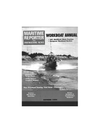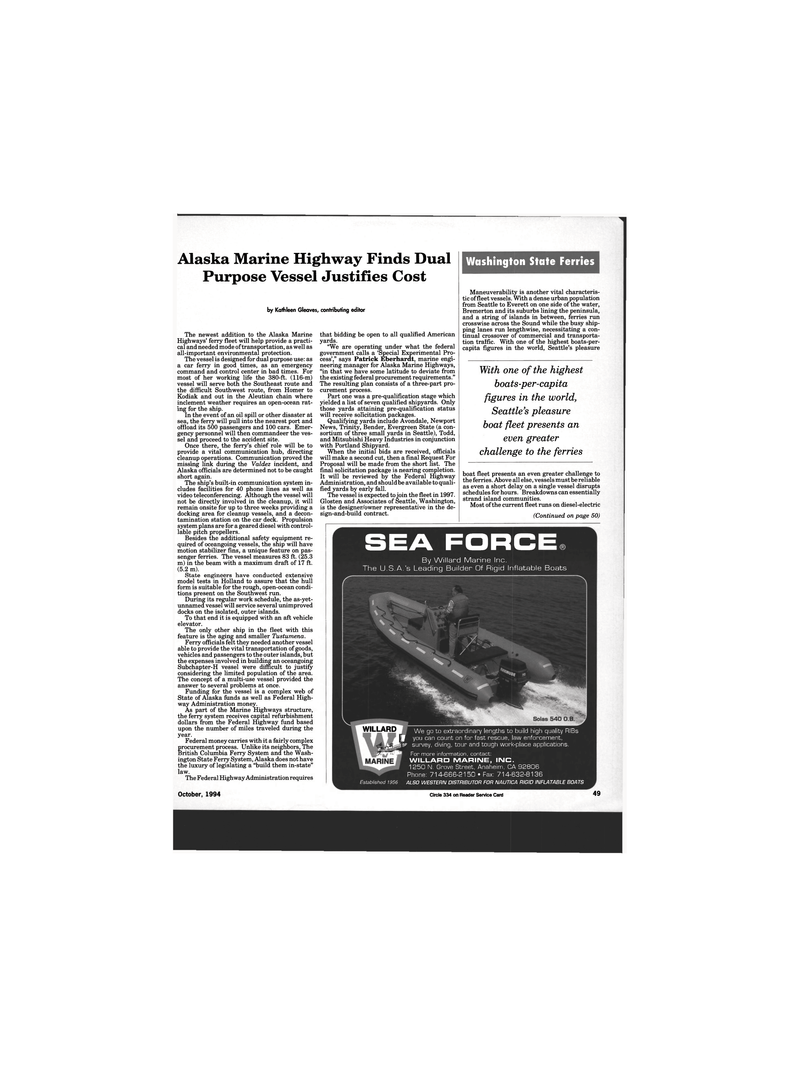
Page 62: of Maritime Reporter Magazine (October 1994)
Read this page in Pdf, Flash or Html5 edition of October 1994 Maritime Reporter Magazine
Washington State Ferries Alaska Marine Highway Finds Dual
Purpose Vessel Justifies Cost by Kathleen Gleaves, contributing editor
The newest addition to the Alaska Marine
Highways' ferry fleet will help provide a practi- cal and needed mode of transportation, as well as all-important environmental protection.
The vessel is designed for dual purpose use: as a car ferry in good times, as an emergency command and control center in bad times. For most of her working life the 380-ft. (116-m) vessel will serve both the Southeast route and the difficult Southwest route, from Homer to
Kodiak and out in the Aleutian chain where inclement weather requires an open-ocean rat- ing for the ship.
In the event of an oil spill or other disaster at sea, the ferry will pull into the nearest port and offload its 500 passengers and 100 cars. Emer- gency personnel will then commandeer the ves- sel and proceed to the accident site.
Once there, the ferry's chief role will be to provide a vital communication hub, directing cleanup operations. Communication proved the missing link during the Valdez incident, and
Alaska officials are determined not to be caught short again.
The ship's built-in communication system in- cludes facilities for 40 phone lines as well as video teleconferencing. Although the vessel will not be directly involved in the cleanup, it will remain onsite for up to three weeks providing a docking area for cleanup vessels, and a decon- tamination station on the car deck. Propulsion system plans are for a geared diesel with control- lable pitch propellers.
Besides the additional safety equipment re- quired of oceangoing vessels, the ship will have motion stabilizer fins, a unique feature on pas- senger ferries. The vessel measures 83 ft. (25.3 m) in the beam with a maximum draft of 17 ft. (5.2 m).
State engineers have conducted extensive model tests in Holland to assure that the hull form is suitable for the rough, open-ocean condi- tions present on the Southwest run.
During its regular work schedule, the as-yet- unnamed vessel will service several unimproved docks on the isolated, outer islands.
To that end it is equipped with an aft vehicle elevator.
The only other ship in the fleet with this feature is the aging and smaller Tustumena.
Ferry officials felt they needed another vessel able to provide the vital transportation of goods, vehicles and passengers to the outer islands, but the expenses involved in building an oceangoing
Subchapter-H vessel were difficult to justify considering the limited population of the area.
The concept of a multi-use vessel provided the answer to several problems at once.
Funding for the vessel is a complex web of
State of Alaska funds as well as Federal High- way Administration money.
As part of the Marine Highways structure, the ferry system receives capital refurbishment dollars from the Federal Highway fund based upon the number of miles traveled during the year.
Federal money carries with it a fairly complex procurement process. Unlike its neighbors, The
British Columbia Ferry System and the Wash- ington State Feriy System, Alaska does not have the luxury of legislating a "build them in-state" law.
The Federal Highway Administration requires that bidding be open to all qualified American yards. "We are operating under what the federal government calls a 'Special Experimental Pro- cess'," says Patrick Eberhardt, marine engi- neering manager for Alaska Marine Highways, "in that we have some latitude to deviate from the existing federal procurement requirements."
The resulting plan consists of a three-part pro- curement process.
Part one was a pre-qualification stage which yielded a list of seven qualified shipyards. Only those yards attaining pre-qualification status will receive solicitation packages.
Qualifying yards include Avondale, Newport
News, Trinity, Bender, Evergreen State (a con- sortium of three small yards in Seattle), Todd, and Mitsubishi Heavy Industries in conjunction with Portland Shipyard.
When the initial bids are received, officials will make a second cut, then a final Request For
Proposal will be made from the short list. The final solicitation package is nearing completion.
It will be reviewed by the Federal Highway
Administration, and should be available to quali- fied yards by early fall.
The vessel is expected to join the fleet in 1997.
Glosten and Associates of Seattle, Washington, is the designer/owner representative in the de- sign-and-build contract.
Maneuverability is another vital characteris- tic of fleet vessels. With a dense urban population from Seattle to Everett on one side of the water,
Bremerton and its suburbs lining the peninsula, and a string of islands in between, ferries run crosswise across the Sound while the busy ship- ping lanes run lengthwise, necessitating a con- tinual crossover of commercial and transporta- tion traffic. With one of the highest boats-per- capita figures in the world, Seattle's pleasure
With one of the highest boats-per-capita figures in the world,
Seattle's pleasure boat fleet presents an even greater challenge to the ferries boat fleet presents an even greater challenge to the ferries. Above all else, vessels must be reliable as even a short delay on a single vessel disrupts schedules for hours. Breakdowns can essentially strand island communities.
Most of the current fleet runs on diesel-electric (Continued on page 50)
SEA FORC
By Willard Marine Inc.
The U.S.A.'s Leading Builder Of Rigid Inflatable Boats
WILLARD We go to extraordinary lengths to build high quality RIBs f you can count on for fast rescue, law enforcement, ^ survey, diving, tour and tough work-place applications.
For more information, contact:
WILLARD MARINE, INC. 1250 N. Grove Street, Anaheim, CA 92806
Phone: 714-666-2150 • Fax: 714-632-8136
Established 1956 ALSO WESTERN DISTRIBUTOR FOR NAUTICA RIGID INFLATABLE BOATS
October, 1994 Circle 334 on Reader Service Card 49

 61
61

 63
63
